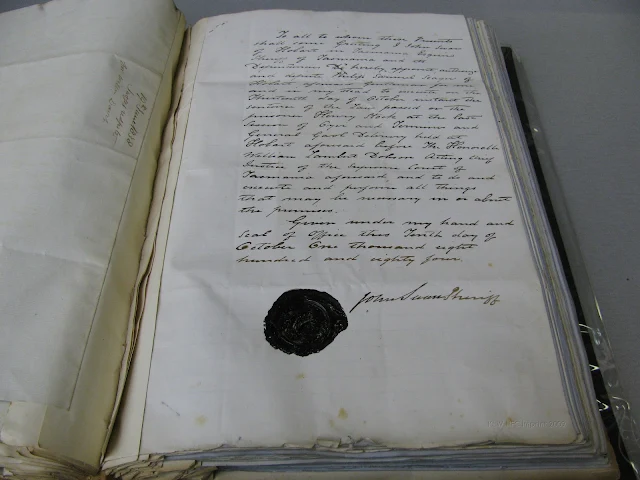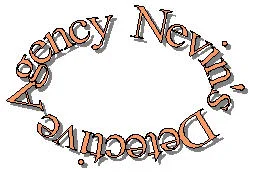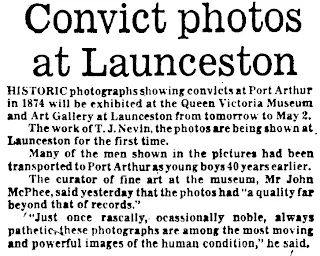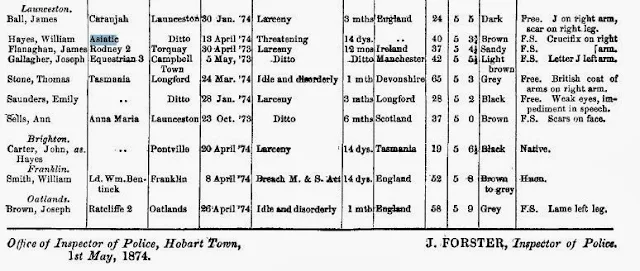EXECUTIONS at the Hobart Gaol, Tasmania 1880s
T. J. NEVIN POLICE MUGSHOTS hand tinted cdvs
The prisoner photographs
This carte-de-visite in an oval mount is a booking shot of Henry Stock still wearing his fine street clothes. It was taken by government contractor T. J. Nevin when Stock was incarcerated at the Hobart Gaol in July 1883. Even as late as the mid 1880s, Thomas Nevin, assisted by his brother Constable John Nevin who was armed in sessions involving violent prisoners, continued to compose and print mugshots of prisoners for police and prison records within the conventions and techniques of 1870s commercial studio portraiture. This cdv may have been taken soon after Henry Stock's arraignment at the Supreme Court, Hobart, 24 July 1883, charged with forgery, and reprised a year later to accompany his death warrant when he was arrested for the murder of his wife in September 1884. Bequeathed from collector David Scott Mitchell's estate in 1907, both the photograph and death warrant were certainly the property of the Tasmanian government when collated in Volume 2, Tasmania Supreme Court Death warrants and related papers, 1818-1884 (C 203), held at the State Library of NSW.

Henry Stock: carte-de-visite photograph by T. J. Nevin in buff mount pasted opposite death warrant dated 13 September 1884
Death Warrants V.D.L. Tasmania Supreme Court. Mitchell Library C203.
Photos copyright © KLW NFC Imprint 2009
Thomas Nevin photographed James Sutherland immediately prior to his execution on 4th June, 1883 at the Hobart Gaol. The carte was hand-tinted in a similar fashion to the cdv mugshots taken by Thomas Nevin of prisoners Bramall aka Johnstone and Job Smith aka Campbell, held at the National Library of Australia and the Tasmanian Museum and Art Gallery. The colouring of these mugshots served two purposes: to render a more accurate image reflective of reality, i.e. blue for blue eyes, blue for the prison issue scarf, especially when the man was wanted on warrant; and to profit from the sale of the hanged man's image to the press and the public. These were called "ornaments of colour", a term used in reference to Thomas Nevin's tinting of prisoner photographs in the Mercury newspaper's account of Nevin's incident with the "ghost" (December 4, 1880).

Detail: hand-tinting on photograph by T. J. Nevin of James Sutherland, June 1883
Carte-de-visite in buff mount pasted on page opposite of Sutherland's death warrant
Death Warrants V.D.L. Tasmania Supreme Court. Mitchell Library C203.
Photos copyright © KLW NFC Imprint 2009
The death warrants

Death Warrants V.D.L. Tasmania Supreme Court. Mitchell Library SLNSW C203.
Photo copyright © KLW NFC Imprint 2009
Catalogue Notes: State Library of NSW
Tasmania. Supreme Court - Death warrants and related papers, 1818-1884Death Warrant for Henry Stock
Creator: Tasmania. Supreme Court
Call Number: C 202 - C 203
Date: 1818 - 1884
Contents: 1818-1884; Death warrants for the execution of prisoners in Tasmania; with related papers including receipts for bodies received at hospitals, orders for sentences to be commuted to penal servitude for life, and for transportation to Macquarie Harbour. There are two photographs in volume 2 (C 203) which may be of James Sutherland in 1883 and Henry Stock in 1884. (Call No.: ML C 202 - C 203) Arrangement: The warrants and papers are not in chronological order within the two volumes; volume 1 contains documents dated between 1818-1855 and volume 2 between 1827-1884.
Source: Mitchell Bequest, 1907. State Library of NSW, Sydney.

Henry Stock: carte-de-visite photograph in buff mount pasted opposite death warrant, 13 September 1884
Death Warrants V.D.L. Tasmania Supreme Court. Mitchell Library Z/C203.
Photos copyright © KLW NFC Imprint 2009
TRANSCRIPT
To the SHERIFF of Tasmania and to the Keeper of Her Majesty's Gaol at Hobart in Tasmania, jointly and severally.
Whereas at a Session of Oyer and Terminer and General Gaol Delivery of the Supreme Court of Tasmania holden at Hobart in Tasmania aforesaid on Thursday the Twenty third day of September instant Henry Stock was convicted before me of the murder of Elizabeth Stock and thereupon for that Offence received Sentence to be hanged by the neck until he should be dead - NOW IT IS HEREBY ORDERED that executing of the said Sentence be accordingly made and done upon the said Henry Stock on Monday the Thirteenth day of October next at the usual Hour and Place of Execution, and that his body when dead be buried privately by the Sheriff.
Given under my Hand and Seal at Hobart in Tasmania aforesaid this Thirteenth day of September in the year of our Lord One thousand eight hundred and eighty four.
[signed by W. L. Dobson and stamped with the Royal Arms colonial seal ]

John Swan Sheriff, 10 October 1884: his authorisation for the execution of prisoner Henry Stock.
Death Warrants V.D.L. Tasmania Supreme Court. Mitchell Library Z/C203.
Photo copyright © KLW NFC Imprint 2009
TRANSCRIPT
To all to whom those present shall come Greeting. I John Swan of Hobart in Tasmania Esquire, Sheriff of Tasmania and its Dependencies hereby appoint, authorize depute Philip Samuel Seager of Hobart aforesaid Gentleman for me and in my stead to execute on the Thirteenth day of October instant the sentence of the Law passed on the prisoner Henry Stock at the last Session of Oyer and Terminer and General Gaol Delivery held at Hobart aforesaid before the Honorable William Lambert Dobson Acting Chief Justice of the Supreme Court of Tasmania aforesaid, and to do and execute and perform all things that may be necessary in or about the premises.The use of the word "execute" in this warrant, given the circumstances, is misleading. At a glance, it might appear that Sheriff John Swan was authorising his deputy Philip Samuel Seager to perform the hangman's duty, to carry out the actual execution of the prisoner. His use of the word "execute" twice in this document, though unfortunate given the context, is correct idiomatic English, meaning to put a plan or order into action. John Swan had only deputised Seager to carry out the order - to "execute ... the sentence of the law", and to "to execute and perform all things that may be necessary in or about the premises" in preparation for the execution of Henry Stock; the actual hangman for this and several other executions at the Hobart Gaol was the socially shunned Solomon Bray (Breay, var. spelling of father's name). He pinioned the prisoner. i.e. tied his hands and legs with leather straps, according to this summary from the Daily Telegraph (Launceston):
Given under my hand and Seal of Office this Tenth day of October One thousand eight hundred and eighty four. John Swan Sheriff.
[signed by John Swan and stamped with the Royal Arms colonial seal]
EXECUTION OF STOCK. The execution of Henry Stock, who was convicted at the last Criminal Sessions of the murder of his wife and child, took place at 8 o'clock this morning, in the presence of Messrs. Seager, the Deputy Sheriff; Quodling, the Governor of the Gaol ; Hedberg, Sub Inspector of the Territorial Police ; Smith, the Under Gaoler : Rev. Geo. W. Shoobridge, Chaplain to the Gaol ; Rev. T. M. O'Callaghan ; the members of the Press, and the gaol officials. On Mr Seager asking Stock whether he had anything to say, he replied, 'All I have to say is that I am innocent.' When asked whether he had any message he would like taken to anybody, he replied ' .No.' He was then pinioned by Solomon Blay, and he followed Mr Shoobridge to the drop. The condemned man appeared somewhat faint, but his step was firm, and he walked on to the platform bravely and exhibited no signs of breaking down. In his right hand he carried a little bunch of flowers with the following text attached : ' He shall speak peace unto the heathen.' He then mounted the platform, the white cap was placed over his head, the bolt drawn, and the unfortunate man launched into eternity. The operation took over three minutes, Mr Shoobridge continuing the prayer during the whole time. Whilst in gaol Stock was respectful to all the officials. Up to the time of his death he made no confession. On Sunday night his rest was partially disturbed, but this morning he eat [sic - ate] a hearty breakfast of fish. The body was cut down after an hour's time and examined by Dr. Turnley, who pronounced the body to be dead. His remains were conveyed at 11 o'clock to Cornelian Bay. Mr A. J. Taylor took cast of his head.Execution of Stock. Daily Telegraph (Launceston, Tas. : 1883 - 1928), Tuesday 14 October 1884, page 2
Death Warrant for James Sutherland

Death warrant and photograph of James Sutherland
Mitchell Library SLNSW Vol 2, C203
Photo copyright © KLW NFC Imprint 2009
TRANSCRIPT
To the SHERIFF of Tasmania and to the Keeper of her Majesty's Gaol at Hobarton jointly and severally.
Whereas at a Session of Oyer and Terminer and General Gaol Delivery of the Supreme Court of Tasmania holden at Hobart in Tasmania aforesaid on Tuesday the fifteenth day of May James Sutherland was convicted before the [blank] of the murder of William Wilson and thereupon for that Offence received Sentence to be hanged by the neck until he should be dead - NOW IT IS ORDERED that execution of the said Sentence be accordingly made and done upon the said James Sutherland on Monday the fourth day of June at the Usual Hour and Place of Execution and that his body when dead be buried privately by the Sheriff -
Given under my Hand and Seal at - Hobart in Tasmania aforesaid this twenty third day of May in the year of Our Lord One thousand eight hundred and eighty three.
[Signature of Francis Smith CJ (Chief Justice) and black seal of Royal Arms colonial warrant].

Justice Sir Francis Smith's and the Deputy Sheriff Philip S. Seager's signed confirmation of Sutherland's execution.
Death Warrants V.D.L. Tasmania Supreme Court. Mitchell Library SLNSW C203
Photo copyright © KLW NFC Imprint 2009
Press report of the execution
Launceston Examiner (Tas. : 1842 - 1899), Tuesday 5 June 1883, page 3Librarian and collector Andrew Taylor took casts of heads for inclusion in his private museum. Solomon Blay was the hangman who was universally shunned by Hobart society. Both men repeated these actions a year later when Henry Stock was hanged for the murder of his wife and her child.
THE LAST SCENE IN THE EPPING TRAGEDY. (BY ELECTRIC TELEGRAPH.) HOBART, June 4. The prisoners James Sutherland and James Ogden, convicted of the murder of William Wilson and Alfred Holman at Epping Forest in April last, were executed this morning at the Campbell-street Gaol. The Rev. J. C. Mace had been with Sutherland from early morn, and the Rev. G. W. Shoobridge with Ogden. Neither of the prisoners had slept dur-ing the night, saying that they would see as much as they could of the world that was so soon to be left, and both softened in their demeanour during the night. This morning Sutherland requested Mr. Mace to send to Mrs. Wilson and Mrs. Holman and ask them to forgive him, and he also spoke bitterly of the treatment he had received during his lifetime, saying the world had not been a pleasant one to him, that he had had no parents to look after him, but had been kicked about by those who got as much work as possible out of him without caring in the least about him. He also said he had thought a good deal more about his position than people had given him credit for. Both prisoners seemed to realise their position. Only three spectators, exclusive of the officials, police, and representatives of the Press, were present at the final scene this morning. Before leaving their cells both prisoners were asked by the Deputy Sheriff, Mr. Seager, if they had anything to say, but both replied in the negative. There was little change in the appearance of Sutherland, but Ogden's features were heavy and swollen. At 8.5 a.m. they left their cells, after having been pinioned by Solomon Blay, the hangman ; and preceded by the Rev. Mr. Shoobridge, reading a portion of the Church of England burial service, both men walked calmly along the bridge leading to the scaffold, Sutherland's step being as firm as ordinarily, while Ogden, who carried in his right hand a bunch of flowers sent to him through the Rev. Mr. Shoobridge by a little girl attending Trinity Church Sunday-school, trembled violently, but otherwise made no sign. When the hangman placed the noose round Sutherland's neck he pulled himself together, never flinching, Ogden also keeping firm, and the muscles of neither of their faces moved as the fatal cap was drawn over their heads. The bolt was drawn at 8.10 a.m., and side by side the unfortunate lads were launched into eternity. Standing on the scaffold they looked more boyish than ever, making it difficult to believe them the perpetrators of the deeds for which they justly suffered death. Mrs. Ogden states that it was reading the history of the Kelly gang caused the boys to commit these crimes. After hanging an hour the bodies were out down, the little bouquet sent to Ogden being found tightly clenched in his hand, and Dr. Graham certified that both were dead. Casts of their heads were then taken by Mr. A. J. Taylor, and at 12.30 p.m. the bodies were placed in a hearse by Mr. W. F. Potterd, the Government contracting undertaker, and conveyed to the Cornelian Bay Cemetery, where they were interred by the gaol officials without any religious ceremony. The execution of these two prisoners makes over a hundred persons executed by Solomon Blay. The last execution at Hobart was that of Richard Copping, for murder at Sorell, on 21st October, 1878.
The black seal attached to these Supreme Court of Tasmania warrants is the Royal Arms insignia used by the colonial government on all their judicial documents. It was also designated for use as Thomas J. Nevin's government contractor studio stamp which was printed on the versos of prisoner photographs (one per batch of 100 was submitted for his commission while still operating as a commercial photographer), and on the versos of photographs taken of government officials and their families. For more detail on Sutherland's crime, see this article on this site: Execution of Sutherland and Ogden
RELATED POSTS main weblog
- John Nevin at inquest for James Thornton 1889
- Two mugshots of convict Hugh COHEN or Cowen/Cowan 1878
- Prisoner Richard COPPING and Hobart Gaol executions
- Prisoner Robert aka James OGDEN, photographed by T. J. Nevin 1875
- Two histories, two inscriptions: Tasmanian prisoners 1874
- Nevin's mugshots: the transitional pose and frame
- Execution of Sutherland and Ogden, Hobart Gaol 1883













.jpg)
















